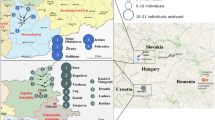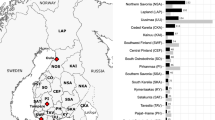Abstract
The most frequent Y-chromosomal (chrY) haplogroups in northern and eastern Europe (NEE) are well-known and thoroughly characterised. Yet a considerable number of men in every population carry rare paternal lineages with estimated frequencies around 5%. So far, limited sample-sizes and insufficient resolution of genotyping have obstructed a truly comprehensive look into the variety of rare paternal lineages segregating within populations and potential signals of population history that such lineages might convey. Here we harness the power of massive re-sequencing of human Y chromosomes to identify previously unknown population-specific clusters among rare paternal lineages in NEE. We construct dated phylogenies for haplogroups E2-M215, J2-M172, G-M201 and Q-M242 on the basis of 421 (of them 282 novel) high-coverage chrY sequences collected from large-scale databases focusing on populations of NEE. Within these otherwise rare haplogroups we disclose lineages that began to radiate ~1–3 thousand years ago in Estonia and Sweden and reveal male phylogenetic patterns testifying of comparatively recent local demographic expansions. Conversely, haplogroup Q lineages bear evidence of ancient Siberian influence lingering in the modern paternal gene pool of northern Europe. We assess the possible direction of influx of ancestral carriers for some of these male lineages. In addition, we demonstrate the congruency of paternal haplogroup composition of our dataset with two independent population-based cohorts from Estonia and Sweden.
This is a preview of subscription content, access via your institution
Access options
Subscribe to this journal
Receive 12 print issues and online access
$259.00 per year
only $21.58 per issue
Buy this article
- Purchase on SpringerLink
- Instant access to full article PDF
Prices may be subject to local taxes which are calculated during checkout



Similar content being viewed by others
Data availability
The Estonian WGS data are available on demand through the Estonian Biobank: https://www.geenivaramu.ee/en/biobank.ee/data-access. In accordance to the consent form signed by the customers of Gene by Gene commercial genetic testing company, the sequencing data included in this study is used for the sole purpose of scientific inquiry and is reported here on an aggregate level in the form of phylogenetic trees. For both the Estonian Biobank and the Gene by Gene samples, summary-level data including variable positions and their frequency in the cohort population have been deposited to dbSNP with links to BioProject accession number PRJNA718714 in the NCBI BioProject database (https://www.ncbi.nlm.nih.gov/bioproject/). The Swedish data from the SweGen Project is available upon request from the original authors of the project [23].
References
Pankratov V, Montinaro F, Kushniarevich A, Hudjashov G, Jay F, Saag L et al. Differences in local population history at the finest level: the case of the Estonian population. Eur J Hum Genet. 2020; 28:1580–1591.
Tambets K, Yunusbayev B, Hudjashov G, Ilumäe AM, Rootsi S, Honkola T, et al. Genes reveal traces of common recent demographic history for most of the Uralic-speaking populations. Genome Biol. 2018;19:1–20.
Lappalainen T, Laitinen V, Salmela E, Andersen P, Huoponen K, Savontaus ML, et al. Migration waves to the baltic sea region. Ann Hum Genet. 2008;72:337–348.
Karlsson AO, Wallerström T, Götherström A, Holmlund G. Y-chromosome diversity in Sweden - a long-time perspective. Eur J Hum Genet. 2006;14:963–970.
Balanovsky O, Rootsi S, Pshenichnov A, Kivisild T, Churnosov M, Evseeva I, et al. Two sources of the Russian patrilineal heritage in their Eurasian context. Am J Hum Genet. 2008;82:236–250.
Kushniarevich A, Utevska O, Chuhryaeva M, Agdzhoyan A, Dibirova K, Uktveryte I et al. Genetic heritage of the balto-slavic speaking populations: A synthesis of autosomal, mitochondrial and Y-chromosomal data. PLoS One. 2015; 10. https://doi.org/10.1371/journal.pone.0135820.
Jones ER, Zarina G, Moiseyev V, Lightfoot E, Nigst PR, Manica A, et al. The Neolithic transition in the Baltic was not driven by admixture with early European farmers. Curr Biol. 2017;27:576–582.
Lamnidis TC, Majander K, Jeong C, Salmela E, Wessman A, Moiseyev V et al. Ancient Fennoscandian genomes reveal origin and spread of Siberian ancestry in Europe. Nat Commun. 2018; 9. https://doi.org/10.1038/s41467-018-07483-5.
Saag L, Laneman M, Varul L, Malve M, Valk H, Razzak MA, et al. The arrival of Siberian ancestry connecting the Eastern Baltic to Uralic speakers further East. Curr Biol. 2019;29:1701–1711.e16.
Myres NM, Rootsi S, Lin AA, Järve M, King RJ, Kutuev I, et al. A major Y-chromosome haplogroup R1b Holocene era founder effect in Central and Western Europe. Eur J Hum Genet. 2011;19:95–101.
Underhill PA, Poznik GD, Rootsi S, Järve M, Lin AA, Wang J, et al. The phylogenetic and geographic structure of Y-chromosome haplogroup R1a. Eur J Hum Genet. 2015;23:124–131.
Ilumäe AM, Reidla M, Chukhryaeva M, Järve M, Post H, Karmin M, et al. Human Y chromosome haplogroup N: a non-trivial time-resolved phylogeography that cuts across language families. Am J Hum Genet. 2016;99:163–173.
Karmin M, Saag L, Vicente M, Wilson Sayres MA, Järve M, Gerst Talas U, et al. A recent bottleneck of Y chromosome diversity coincides with a global change in culture. Genome Res. 2015;25:459–466.
Batini C, Hallast P, Zadik D, Delser PM, Benazzo A, Ghirotto S et al. Large-scale recent expansion of European patrilineages shown by population resequencing. Nat Commun. 2015; 6. https://doi.org/10.1038/ncomms8152.
Rootsi S, Myres NM, Lin AA, Järve M, King RJ, Kutuev I, et al. Distinguishing the co-ancestries of haplogroup G Y-chromosomes in the populations of Europe and the Caucasus. Eur J Hum Genet. 2012;20:1275–1282.
Cruciani F, La Fratta R, Trombetta B, Santolamazza P, Sellitto D, Colomb EB, et al. Tracing past human male movements in northern/eastern Africa and western Eurasia: New clues from Y-chromosomal haplogroups E-M78 and J-M12. Mol Biol Evol. 2007;24:1300–1311.
Karafet TM, Osipova LP, Gubina MA, Posukh OL, Zegura SL, Hammer MF. High levels of Y-chromosome differentiation among native Siberian populations and the genetic signature of a boreal Hunter-Gatherer way of life. Hum Biol. 2002;74:761–789.
Dulik MC, Zhadanov SI, Osipova LP, Askapuli A, Gau L, Gokcumen O, et al. Mitochondrial DNA and Y chromosome variation provides evidence for a recent common ancestry between Native Americans and indigenous Altaians. Am J Hum Genet. 2012;90:229–246.
Hallast P, Batini C, Zadik D, Delser PM, Wetton JH, Arroyo-Pardo E, et al. The Y-chromosome tree bursts into leaf: 13,000 high-confidence SNPs covering the majority of known clades. Mol Biol Evol. 2014;32:661–673.
Poznik GD, Xue Y, Mendez FL, Willems TF, Massaia A, Wilson Sayres MA, et al. Punctuated bursts in human male demography inferred from 1,244 worldwide Y-chromosome sequences. Nat Genet. 2016;48:593–599.
Leitsalu L, Haller T, Esko T, Tammesoo ML, Alavere H, Snieder H, et al. Cohort profile: Estonian biobank of the Estonian genome center, university of Tartu. Int J Epidemiol. 2015;44:1137–1147.
Mitt M, Kals M, Pärn K, Gabriel SB, Lander ES, Palotie A, et al. Improved imputation accuracy of rare and low-frequency variants using population-specific high-coverage WGS-based imputation reference panel. Eur J Hum Genet. 2017;25:869–876.
Ameur A, Dahlberg J, Olason P, Vezzi F, Karlsson R, Martin M, et al. SweGen: A whole-genome data resource of genetic variability in a cross-section of the Swedish population. Eur J Hum Genet. 2017;25:1253–1260.
Li H. Aligning sequence reads, clone sequences and assembly contigs with BWA-MEM. arXiv. 2013. https://arxiv.org/abs/1303.3997.
Poplin R, Ruano-Rubio V, DePristo MA, Fennell TJ, Carneiro MO, Auwera GA Van der et al. Scaling accurate genetic variant discovery to tens of thousands of samples. bioRxiv. 2017. https://doi.org/10.1101/201178.
Li H, Handsaker B, Wysoker A, Fennell T, Ruan J, Homer N, et al. The sequence alignment/map format and SAMtools. Bioinformatics. 2009;25:2078–2079.
Poznik GD. Identifying Y-chromosome haplogroups in arbitrarily large samples of sequenced or genotyped men. bioRxiv. 2016. https://doi.org/10.1101/088716.
Severson AL, Shortt JA, Mendez FL, Wojcik GL, Bustamante CD, Gignoux CR. SNAPPY: single nucleotide assignment of phylogenetic parameters on the Y chromosome. bioRxiv. 2018. https://doi.org/10.1101/454736.
Drummond AJ, Suchard MA, Xie D, Rambaut A. Bayesian phylogenetics with BEAUti and the BEAST 1.7. Mol Biol Evol. 2012;29:1969–1973.
Lemey P, Rambaut A, Welch JJ, Suchard MA. Phylogeography takes a relaxed random walk in continuous space and time. Mol Biol Evol. 2010;27:1877–1885.
Pybus OG, Suchard MA, Lemey P, Bernardin FJ, Rambaut A, Crawford FW, et al. Unifying the spatial epidemiology and molecular evolution of emerging epidemics. Proc Natl Acad Sci USA. 2012;109:15066–15071.
Sahakyan H, Margaryan A, Saag L, Karmin M, Bahmanimehr A, Parik J. et al. Origin and diffusion of human Y chromosome haplogroup J1‑M267. Sci Rep. 2021; https://doi.org/10.1038/s41598-021-85883-2.
Suchard MA, Lemey P, Baele G, Ayres DL, Drummond AJ, Rambaut A. Bayesian phylogenetic and phylodynamic data integration using BEAST 1.10. Virus Evol. 2018;4:1–5.
Ayres DL, Darling A, Zwickl DJ, Beerli P, Holder MT, Lewis PO, et al. BEAGLE: an application programming interface and high-performance computing library for statistical phylogenetics. Syst Biol. 2012;61:170–173.
Bielejec F, Baele G, Vrancken B, Suchard MA, Rambaut A, Lemey P. SpreaD3: interactive visualization of spatiotemporal history and trait evolutionary processes. Mol Biol Evol. 2016;33:2167–2169.
Trombetta B, D’Atanasio E, Massaia A, Myres NM, Scozzari R, Cruciani F, et al. Regional differences in the accumulation of SNPs on the male-specific portion of the human y chromosome replicate autosomal patterns: Implications for genetic dating. PLoS One. 2015;10:1–18.
Finocchio A, Trombetta B, Messina F, D’Atanasio E, Akar N, Loutradis A, et al. A finely resolved phylogeny of y chromosome Hg J illuminates the processes of Phoenician and Greek colonizations in the Mediterranean. Sci Rep. 2018;8:3–11.
Zalloua PA, Platt DE, El Sibai M, Khalife J, Makhoul N, Haber M, et al. Identifying genetic traces of historical expansions: phoenician footprints in the mediterranean. Am J Hum Genet. 2008;83:633–642.
Jones ER, Gonzalez-Fortes G, Connell S, Siska V, Eriksson A, Martiniano R et al. Upper Palaeolithic genomes reveal deep roots of modern Eurasians. Nat Commun. 2015; 6. https://doi.org/10.1038/ncomms9912.
Mathieson I, Lazaridis I, Rohland N, Mallick S, Patterson N, Roodenberg SA, et al. Genome-wide patterns of selection in 230 ancient Eurasians. Nature. 2015;528:499–503.
Yunusbayev B, Metspalu M, Ja M, Kutuev I, Rootsi S, Metspalu E, et al. The Caucasus as an asymmetric semipermeable barrier to ancient human migrations research article. Mol Biol Evol. 2012;29:359–365.
Zegura SL, Karafet TM, Zhivotovsky LA, Hammer MF. High-resolution SNPs and microsatellite haplotypes point to a single, recent entry of Native American Y chromosomes into the Americas. Mol Biol Evol. 2004;21:164–175.
Kittles RA, Bergen AW, Urbanek M, Virkkunen M, Linnoila M, Goldman D, et al. Autosomal, mitochondrial, and Y chromosome DNA variation in Finland: evidence for a male-specific bottleneck. Am J Phys Anthropol. 1999;108:381–399.
Martin AR, Karczewski KJ, Kerminen S, Kurki MI, Sarin AP, Artomov M, et al. Haplotype sharing provides insights into fine-scale population history and disease in Finland. Am J Hum Genet. 2018;102:760–775.
Fu Q, Posth C, Hajdinjak M, Petr M, Mallick S, Fernandes D, et al. The genetic history of Ice Age Europe. Nature. 2016;534:200–205.
Mathieson I, Alpaslan-Roodenberg S, Posth C, Szécsényi-Nagy A, Rohland N, Mallick S, et al. The genomic history of southeastern Europe. Nature. 2018;555:197–203.
Grugni V, Raveane A, Ongaro L, Battaglia V, Trombetta B, Colombo G, et al. Analysis of the human Y-chromosome haplogroup Q characterizes ancient population movements in Eurasia and the Americas. BMC Biol. 2019;17:1–14.
Raghavan M, Skoglund P, Graf KE, Metspalu M, Albrechtsen A, Moltke I et al. Upper palaeolithic Siberian genome reveals dual ancestry of native Americans. Nature. 2014; 505. https://doi.org/10.1038/nature12736.
Marchi N, Winkelbach L, Schulz I, Brami M, Hofmanová Z. The mixed genetic origin of the first farmers of Europe. bioRxiv. 2020. https://doi.org/10.1101/2020.11.23.394502.
Funding
This work was supported by institutional research funding IUT24-1 of the Estonian Ministry of Education and Research, Estonian Research Council grants PRG243, PRG1071 and project No. 2014-2020.4.01.16-0024 (MOBTT53) granted by the European Regional Development Fund, European Union Horizon 2020 research and innovation programme (grant No. 810645), European Regional Development Fund project no. MOBEC008. A-MI is supported by Finnish Academy (DIGIHUM project URKO, decision number 329257). High-coverage genome data for five 1000 Genomes samples were generated at the New York Genome Center with funds provided by NHGRI Grant 3UM1HG008901-03S1.
Author information
Authors and Affiliations
Corresponding author
Ethics declarations
Conflict of interest
DMB and CB declare stock ownership at Gene by Gene, Ltd. LFS in an employee of Gene by Gene.
Ethics approval
All donors have provided informed consent and all experiments were performed in accordance with the relevant guidelines and regulations of collaborating institutions. Access to genetic data in Estonian Biobank was approved by the Research Ethics Committee of the University of Tartu (permission number 1.1.-12/659 granted by the Research Ethics Committee of the University of Tartu, Estonia). The chrY sequences included from customers of the commercial personal genetic testing service were only from individuals who had provided informed consent for the use of their data in scientific research and for publication in aggregated form. The list of IDs along with additional sample information is presented in Supplementary Table S1.
Additional information
Publisher’s note Springer Nature remains neutral with regard to jurisdictional claims in published maps and institutional affiliations.
Rights and permissions
About this article
Cite this article
Ilumäe, AM., Post, H., Flores, R. et al. Phylogenetic history of patrilineages rare in northern and eastern Europe from large-scale re-sequencing of human Y-chromosomes. Eur J Hum Genet 29, 1510–1519 (2021). https://doi.org/10.1038/s41431-021-00897-8
Received:
Accepted:
Published:
Issue date:
DOI: https://doi.org/10.1038/s41431-021-00897-8



